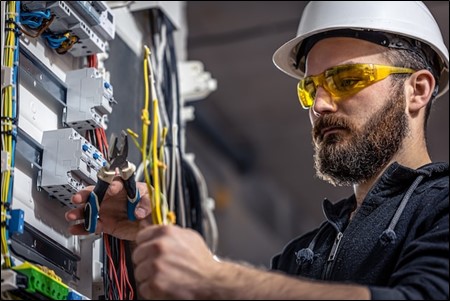Introduction – An electrical panel, also known as a breaker panel, is a small box with a door that is typically incorporated into a wall in a secluded area of your home. The breaker switches for your home are all found inside. It is possible to turn breakers on and off via switches. They are designed to shut off automatically if excessive electrical current flows through them. There is a standard circuit breaker in the electrical panel that regulates the electricity to the entire house. Additionally, you’ll see separate breakers, each of which is in charge of supplying electricity to a different area of your house. Each circuit breaker should be labeled to indicate the area of the house it controls.
- Locating your electric panel –
Metal boxes that are usually grey in color are electrical panels. It is common practice to install them into a wall.
There are doors on electrical panels. Behind the door are various wires and switches; the latter are your circuit breakers.
Typically, electrical panels are located in a remote area of your house. An electrical panel is frequently installed in garages, basements, laundry rooms, storage rooms, or storage rooms. You might even need to search outside for your panel in some older houses.
A common location for the panel is behind a bedroom door or immediately inside the apartment itself, near the front door.
- The functioning of an electric panel –
When a circuit is overloaded, circuit breakers trip, which causes them to shut off. They are precautions taken to ensure that the home and its electrical systems are safe. If the breaker didn’t trip and cut off the electricity, an overloaded circuit may start a fire or electrocute someone.
One circuit is controlled by each breaker, and each circuit often correlates to rooms or a section of the home. Power-hungry appliances like air conditioners or electric ranges may have their own breaker. If the current through the breaker exceeds the amount it was designed to handle, the breaker will trip. For instance, this can happen if too many gadgets are plugged into one circuit.
- Things that can go wrong in an electric panel –
- Trip preventer – As was already mentioned, if a circuit is overloaded, a circuit breaker will trip. For instance, you might use your hairdryer while utilizing your desktop computer and TV. They might be connected to the same circuit even though they are all connected to different outlets. The breaker can trip as a result of drawing too much power as a result of this.
- Inadequate ability -It can be a capacity problem if you have a circuit that frequently trips (or numerous breakers).
- Corrosion – Electrical boards or the wiring surrounding them corroding is a sign of moisture buildup. Electricity and moisture do not mix well (obviously).
- Short circuits – Breakers should be instantly tripped by short circuits. When you restore a tripped switch, and it trips again right away, the most likely cause is a short circuit.
Conclusion – Your home’s electricity is supplied via an outside electrical meter, which travels to your electrical box. So, these are some important and interesting facts about an electric panel in your home.

